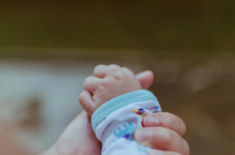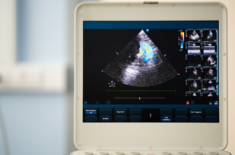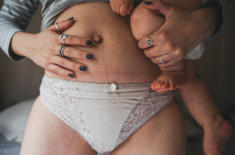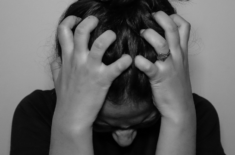Overview
Around 20% of women experience postpartum hair loss, usually after their first pregnancy. (1)
Did you enjoy luscious, healthy hair during pregnancy, but are now losing clumps of it after having a new baby? Don’t be scared, mama. That’s normal. It’s called postpartum alopecia or postpartum hair loss.
We normally lose around 50-100 hair strands a day. (2)
Hormone levels increase during pregnancy, particularly estrogen and progesterone. While these hormonal changes support your baby’s development, they also can cause changes in your hair growth cycle by extending the growth phase. (3)(4)
Thanks to these pregnancy hormones, you get to enjoy fuller hair.
But after giving birth, you might notice your hairline receding, your shower drain filled with hair, or having clumps of hair falling off.
We know this can be an emotional and nerve-wracking experience, especially if you’re a first-time mom.
You might be wondering long does this postpartum hair loss lasts, or if you can go completely bald from it. Are there ways to prevent excessive hair shedding, and will your hair grow back?
7 Effective Prevention & Hair Care Tips For New Moms
Can you stop postpartum hair loss? Probably not. However, you can help your body avoid losing too much hair or experiencing prolonged hair loss by following these recommendations:
1. Practice Good Nutrition
Eat a well-balanced, healthy diet with lots of protein and iron-rich foods.
Foods to improve scalp and hair health can include: (5)
- Red meat, beans, and legumes (rich in protein and iron)
- Dark leafy green vegetables (rich in vitamin C and iron)
- Sweet potatoes and carrots (rich in beta carotene)
- Eggs (rich in vitamin D, biotin, iron, and protein)
- Fish such as salmon (rich in omega-3s, vitamin D, and magnesium)
- Avocados (rich in vitamins E and B12)
- Oysters and other seafood (rich in zinc)
These vitamins can help spur hair growth or slow hair loss. (6)(7)(8)
2. Get Enough Iron
Iron deficiency can cause hair loss. (9)(10)
But it can also lead to anemia (both you and your baby), premature birth, perinatal mortality (stillbirth), and heart failure. (11)(12)
That’s why the WHO (World Health Organization) recommends a daily intake of 30–60 mg of elemental iron for pregnant women. (11)(12)
Talk to your doctor about getting an iron supplement. Taking these supplements can help with you address several health concerns. They aren’t just for managing or preventing hair loss.
3. Get Enough Vitamin D
Basking under the sun is a good way of improving your vitamin D levels. However, fears of skin cancer or living in a place that doesn’t get a lot of sunlight can prevent you from getting enough of this important vitamin.
Because vitamin D deficiency can also put you and your baby at risk for preterm labor, poor weight gain, miscarriage, or poor bone health, it’s a good idea to ask your doctor for recommendations on vitamin D supplementation. (13)(14)
The IOM (Institute of Medicine) recommends daily intake of 400-600 IU (international units) vitamin D for pregnant women. (15)
4. Will Prenatal Vitamins Help Prevent Postpartum Hair Loss?
Prenatal vitamins can help meet your daily nutritional needs.
Talk to your healthcare provider to determine whether you’ll still need separate supplements for iron and vitamin D or if these are already provided in the prenatal vitamins they recommend.
Aside from getting a balanced diet, your doctor might recommend continuing with your prenatal vitamins even after childbirth, and particularly if you’re breastfeeding.
5. Use Essential Oils
Some essential oils can help support healthier scalp and hair.
Examples include:
- Ylang ylang
- Lemongrass
- Tea tree
- Lavender
- Rosemary
- Clary sage
- Cedarwood
6. Be Gentle To Your Hair
Knowing that your hair is prone to breakage, falling out, and damage during the postpartum period, try to be as gentle to it as possible, even during pregnancy.
- Try to avoid trending or popular hairstyles (e.g., tight braids) or treatments (e.g., hair dyes or straightening chemicals) that can damage your hair follicles or cause breakage of hair strands.
- It’s good to avoid heat treatment, flat irons, and blow dryers.
- Brush your hair gently.
- You can ask your favorite stylist for a hairstyle that might be less prone to hair fall. It can be a shorter haircut or a style that can help new hair regrowth blend in with your other hair.
7. Choose The Right Shampoo & Accessories
- A volumizing shampoo can add body to your hair.
- Try to avoid sharp or tight clips and barrettes that can increase the risk of breakage.
- However, barrettes and scrunchies can be better than elastic bands.
- If you aren’t a fan of a short hairstyle, you can also use scarves, bandannas, and headbands to disguise postpartum hair loss in a fun and stylish way.
What Causes Postpartum Hair Loss?
Hair Growth Cycles
The AAD (American Academy of Dermatology Association) explains that losing around 50-100 hair strands a day is normal. That’s part of the hair growth cycle. (2)
Hair actively grows and gets longer during the anagen phase or growing stage. This typically lasts from two to six years. It’s estimated that around 85-90% of hair is in this phase. (18)(19)
Towards the end of this phase, hair enters the catagen phase, which lasts for 1-2 weeks. Only about 1% of hair is in this phase at any given time. Hair follicles become smaller during this phase, and hair growth slows down. (18)
The rest of your hair is in the “telogen phase” or resting stage, which can last 3-4 months. Hair in the resting phase no longer grows. (18)(19)
The strands of hair eventually fall out towards the end of the resting stage. They’re replaced by new hair. (2)
Hormonal Changes During Pregnancy & Postpartum
Our bodies produce more hormones during pregnancy, some of which (such as estrogen and progesterone) are important to help maintain a healthy pregnancy. (4)
Others (such as hPL or human placental lactogen and prolactin) are essential for child development or stimulating your body to produce breastmilk. (3)
Although these hormones have direct functions relating to pregnancy, they can also affect the hair growth cycle. The higher estrogen levels can keep hair in the growth phase, preventing them from following their schedule for the resting stage. (3)
After giving birth, new moms’ hormone levels return to pre-pregnancy amounts. The drop in pregnancy hormones triggers hair to return to its regular growth cycle.
Several hair strands begin the resting phase right away to catch up on their original schedule. So, when the resting stage ends around 3-4 months later, as many as 300 strands of hair can fall out each day.
With so many new changes to your body as a new mom, we know that seeing clumps of hair falling off can be alarming. This condition is known as telogen effluvium or excessive shedding during the telogen phase. (18)
While it’s noticeable because of the volume, it’s not usually something for you to worry about. This excessive hair shedding doesn’t last long and can return to normal by around your baby’s first birthday.
Stress & Postpartum Depression
Mental or physical stress can also lead to hair loss.
Here are some situations that can cause mental or physical stress: (18)
- Childbirth is physically demanding and stressful.
- Breastfeeding can also be physically demanding.
- Postpartum depression or other mood disorders after childbirth can contribute to mental stress.
Nutrient Demands In Pregnancy & Poor Nutrition
Protein & Iron
Nutrients, especially protein and iron, are essential for hair growth and development. However, pregnancy and childbirth can reduce maternal iron reserves. If these levels remain low, they can also contribute to postpartum hair loss. (18)
The same goes for poor nutrition. Nutrient deficiencies can lead to excessive hair shedding if you don’t eat well.
The thyroid gland in your neck produces hormones that regulate metabolism and influence your hair follicles’ health. (3)
Studies show that low levels of ferritin (blood cell proteins that help store iron) may have links to thyroid hormone production, leading to problems like hair loss. (9)(10)
Vitamin D
A 2021 study in The Journal of Cosmetic Dermatology showed that vitamin D deficiency can also play a role in hair loss. (20)
Because of its anti-inflammatory and immunomodulatory properties (it can affect the immune system), studies are also being conducted to determine whether this vitamin can be used for hair loss treatment. (20)
Medication Side Effects
Some medicines, including anticoagulants or blood thinners (e.g., heparin), can cause hair loss. (18)(21)
If your doctor recommends using blood thinners during pregnancy or postpartum, you can be at a higher risk of postpartum hair loss. (18)(21)
Do All Women Experience Postpartum Hair Loss?
No. Not all women experience or notice a dramatic increase in hair shedding during the postpartum period. However, this tends to be more obvious if you have long hair. (1)
How Much Postpartum Shedding Is Considered Normal?
The numbers can vary, and most people don’t really count the fallen hair strands.
Researchers point out that assessing “normal” daily hair loss isn’t easy, but studies show that telogen effluvium can cause excessive shedding of around 300 hair strands per day. (1)
However, shedding 1,000 strands a day is considered extreme and a cause for concern. (1)
Onset & Duration
Is It Normal To Lose Hair At Three Months Postpartum?
Postpartum hair loss doesn’t happen right after your baby is born. It begins around 2-4 months after childbirth. (1)
By this time, other postpartum symptoms have passed, so hair coming out around this time can be worrying for new moms.
How Long Does Postpartum Hair Loss Last?
Peak hair loss occurs around four to five months postpartum and can last for around two months. (1)
Sometimes, it can last longer than 2-3 months and reach around six months. (1)
Can You Go Bald From Postpartum Hair Loss?
No. It’s rare for postpartum hair loss to go on for several months or become a chronic condition. It’s usually followed by full recovery, with or without intervention. (1)
Does Postpartum Hair Loss Grow Back?
Yes. It should slow down by your baby’s first birthday.
Depending on different factors, such as the extent and duration of hair loss, you can recover from postpartum hair loss by around 15 months.
You might notice that your hair doesn’t have the same density as your pre-pregnancy hair.
Is Postpartum Hair Loss Worse In Subsequent Pregnancies?
No. Studies show that postpartum hair loss usually happens after a first pregnancy. However, experiencing it doesn’t automatically put you at risk for having it again in subsequent pregnancies. (1)
What If My Hair Loss Continues?
If your postpartum hair loss continues for longer than six months, it might be best to talk with your doctor to investigate its cause.
There are other possible causes of hair loss, so your extended condition might be due to other reasons:
- Thyroid disorders (such as thyroiditis or inflammation of the thyroid glands)
- Nutrient deficiency conditions such as iron-deficiency anemia (low count of red blood cells, which are important in carrying oxygen to your body’s organs) (11)
What Kind Of Doctor Should I See?
Your family doctor can help, but they might also refer you to a dermatologist.
Something else (such as an illness) may be causing your hair to fall out. An accurate diagnosis is important in finding the best course of treatment for your postpartum hair loss. So, it’s a good idea to see the right doctor.
Is Postpartum Hair Loss Dangerous?
It’s not actually dangerous to you but can potentially lead to a hair tourniquet. This incident happens when a strand of hair wraps around your baby’s finger, toe, or another body part.
The hair strand can wrap so tightly and cut off circulation to that body part or cause an infection. It’s important to remove it immediately.
You can gently unwind the hair or use scissors.
Call your doctor or bring your baby to the ER if you need help to remove the hair.
Although the likelihood of a hair tourniquet is rare, it can still happen.
REFERENCES
(1) https://www.ncbi.nlm.nih.gov/pmc/articles/PMC6709511/
(2) https://www.centerforsurgicaldermatology.com/7-frequently-asked-questions-about-hair-loss/
(3) https://www.ncbi.nlm.nih.gov/pmc/articles/PMC7432488/
(4) https://www.stanfordchildrens.org/en/topic/default?id=hormones-during-pregnancy-85-P01220
(5) https://www.aarp.org/health/conditions-treatments/info-2017/thinning-hair-fd.html
(6) https://www.ncbi.nlm.nih.gov/pmc/articles/PMC5315033/
(7) https://www.ncbi.nlm.nih.gov/pmc/articles/PMC3509882/
(8) https://www.ncbi.nlm.nih.gov/pmc/articles/PMC6380979/
(9) https://pubmed.ncbi.nlm.nih.gov/4031012/
(10) https://www.ncbi.nlm.nih.gov/pmc/articles/PMC7882421/
(11) https://www.mayoclinic.org/diseases-conditions/anemia/symptoms-causes/syc-20351360
(12) https://www.who.int/elena/titles/guidance_summaries/daily_iron_pregnancy/en/
(13) https://www.ncbi.nlm.nih.gov/pmc/articles/PMC3540805/
(14) https://www.ncbi.nlm.nih.gov/pmc/articles/PMC5357731/
(15) https://www.ncbi.nlm.nih.gov/pmc/articles/PMC3046611/
(16) https://www.ncbi.nlm.nih.gov/pmc/articles/PMC7071347/
(17) https://www.ncbi.nlm.nih.gov/pmc/articles/PMC7558284/
(18) https://www.uofmhealth.org/health-library/ug2799
(19) https://pubmed.ncbi.nlm.nih.gov/28613598/
(20) https://pubmed.ncbi.nlm.nih.gov/34553483/
(21) https://www.ncbi.nlm.nih.gov/pmc/articles/PMC4819463/












